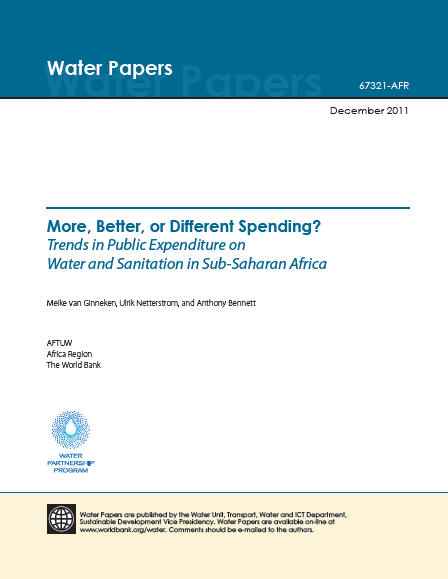More, Better, or Different Spending? Trends in Public Expenditure on Water and Sanitation in Sub-Saharan Africa
 |
report Dec 2011 ; 120 pages
Aut.
Ed. World Bank - Washington
Downloadable format: PdF
Downloadable from the publisher
Editor Presentation
Abstract:
This overview paper tests current public spending patterns against the economic rationale for such spending, including reducing disparities in service delivery and overcoming market failures. Reducing the disparities in access to basic water supply and sanitation (WSS) is a responsibility of government. Individuals have little incentive to build and maintain extensive WSS infrastructure, but communities and societies do. Targeted public spending benefitting households that otherwise would be unable to afford those services can be a component of a broader social policy agenda to redistribute resources to the poor. Several market features call for government intervention in the WSS sector. This review mines the rich data of 15 Public Expenditure Reviews (PERs) conducted in Sub-Saharan Africa and funded by the World Bank over the past years. From 2003 the World Bank has funded more than 40 PERs that contain an analysis of the water supply and sanitation (WSS) sector. In most of these, the WSS sector is discussed alongside other sectors. A set of stand-alone PERs specifically addressing the WSS sector have also been carried out in African countries. The scope of the present review includes expenditures by public institutions (at the central and local government levels) on domestic resources and grants or loans provided by external funding agencies. The review does not include off-budget spending by water utilities. In other words, while the numbers in this review include public subsidies
Keywords: |
access to sanitation (CI) (DT) (ET) (ope) , access to water (CI) (DT) (ET) (ope) , costs, tariffs (CI) (DT) (ET) (ope) , finance (CI) (DT) (ET) (ope) |
Publisher/Broadcaster: |
|
World Bank - Washington - Usa |
If there is a broken link, we will be pleased to receive a message: communication@pseau.org